IPFS

Contents
Introduction
The Internet and The World Wide Web are considered to be some of the greatest inventions of the 20th century. However, while the Internet is built on the principles of decentralization from the ground up, we cannot say so about the Web itself. The majority of the websites is operated by a few hosting companies and most of the static content is served by a few Content Delivery Networks (CDNs). For example, Cloudflare1 currently powers 10% of all internet requests. Since there is a central point of failure, if a provider experiences outage, a large part of the internet goes down. Another issue with the current infrastructure is a crisis of erased history. One cannot expect that a web address visited today will still work in several years from now or that the content will stay the same. In fact, the average lifespan of a webpage is only 75 days2. Last but not least, the current web is not censorship-resistant, and some governments already intentionally restrict their citizens from having access to information3.
These were probably the main motivations why Protocol Labs was founded in May 2014 with the mission to improve Internet technology. They started as a YCombinator company and released an initial version of the InterPlanetary File System (IPFS) in January 2015. IPFS combines the best ideas of Git, BitTorrent and Kademlia to provide a truly decentralized, peer-to-peer hypermedia protocol. In 2016, several modules evolved into separate projects, namely libp2p, IPLD, and Multiformats, all of which constitute the building blocks of IPFS.
The InterPlanetary part of the name pays a homage to Licklider’s Intergalactic Computer Network4, a computer network concept which inspired the development of today’s Internet. In theory, IPFS could one day be actually used on an interplanetary scale, thanks to its peer-to-peer architecture and ability to work in disconnected networks.
Structure of IPFS Project
The IPFS project is well structured into teams to separate responsibilities. There are three project roles that are responsible for the long term vision and coordination of teams – Benevolent Dictator for Life (BDFL), IPFS Project Lead, and IFPS Project Coordinator. These roles are further explained in the stakeholders section. The teams of the project are split into two types: working groups (WG) and research groups. The working groups are developing and deploying software, while the research groups are exploring new areas. Some former working groups (libp2p, IPLD, and Multiformats) have grown to become their own fully separated projects.
The whole IPFS project consists of more than 200 repositories, but in our architectural description we focus on go-ipfs, which serves as a reference implementation of the IPFS protocol. Go-ipfs being a working group of the IPFS project has multiple relations with groups and project roles that are not part of the go-ipfs working group. This is further explained in the power grid.
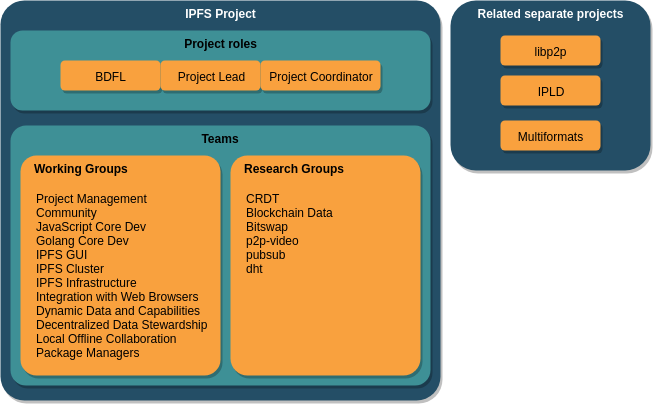
Stakeholders
In this chapter, we will identify stakeholders involved in the go-ipfs project using the categories according to Rozanski & Woods 5, specify managing roles in the overall IPFS project and its relation to the go-ipfs project.
with Stakeholders Using Viewpoints and Perspectives, 2nd Edition. 2011.
Roles
To properly define roles, we inspected the Protocol Labs profile on Crunchbase and various IPFS repositories on GitHub including ipfs-mgmt, where we learned how the IPFS community operates and how it is structured. To identify people most involved in the process of creating code in the go-ipfs project, we analyzed 20 recent (created after 1 September 2018) merged and unmerged Pull Requests with the highest number of comments.
Pull Requests we used can be observed in the following table:
| Type | List of Pull Requests |
|---|---|
| Merged | #5526, #5611, #5789, #5472, #5785, #5455, #5864, #5659, #5501, #5649 |
| Unmerged | #5474, #5583, #5435, #5840, #5464, #5744, #5479,#5570, #5514, #5849 |
The analysis of these Pull Requests provided us with knowledge which developers are actively taking part in the process of code review and also that almost all Pull Request have to be finally accepted and merged by the Captain of go-ipfs (@Stebalien).
It was also helpful to explore issues used for team discussion like a reflection issue or logs from weekly meetings between members. From this, we noticed that the project is developed using Agile approach. The team uses quarterly Objectives and Key Results (OKR), which helps them to communicate goals and achievements on a quarterly basis. Developers work asynchronously and remotely, however, each week there is a weekly call to discuss project related issues, such as the current state of their work and plans for the future.
As contact people, it would be the most helpful to contact developers which participate most actively in Pull Requests and also contribute a lot, as they would possibly have the most significant knowledge about the system structure and various issues they often have to overcome. We would choose @Stebalien, @Kubuxu, and @magik6k.
Results obtained from these various sources can be found below.
| Type | Stakeholders | |
|---|---|---|
| Acquirers | Acquirers are sponsors and distributors of the product. The acquirer of this project is Protocol Labs. | |
| Assessors | These stakeholders are responsible for overseeing conformance to standards and legal regulations. Assessors in the go-ipfs project is Protocol Labs legal department. | |
| Communicators | The interest of this stakeholder is to explain the usage of the system via documentation and training. There are two recent and popular conferences: IPFS Conf 2019, MIT Bitcoin Expo 2018. | |
| Competitors | ZeroNet, Storj, Burst, Genaro, MaidStafe, Dat | |
| Developers | Most of the people involved in work on IPFS are employed by Protocol Labs. People responsible for developing new functionalities and maintaining the project are currently: @Stebalien, @magik6k, @Kubuxu, @hsanjuan, @kevina, @hannahhoward, @eingenito. | |
| Investors | Investors are the stakeholders providing resources to make it possible to continue the development of the system. The main investor of the project is Protocol Labs (mostly sponsored by Union Square Ventures, BlueYard and YCombinator), other investors of the IPFS project are FundersClub, Digital Currency Group. | |
| Maintainers | These stakeholders are responsible for the evolution of the project. The software is in alpha version, however, people trying to maintain the long-distance vision are @daviddias, @Stebalien. | |
| Suppliers | Build or supply hardware and software on which system is working. In this project software used is mostly written in Go and Bash. | |
| Support staff | IPFS has a designated community project for educating about how the IPFS and its tools work and can be exploited. The Captain of the community project is @mikeal. | |
| System administrators | System administrators are people running the software once it has been deployed, and as an idea of IPFS is to be a P2P network, users are the most obvious stakeholders of this type. On the other hand, IPFS project has a designated team of engineers (infra-team) in charge of deploying and maintaining core system infrastructure. | |
| Testers | These stakeholders test if the system is working and ready to be deployed. These are developers and users using a designated TestBed. | |
| Users | This group of stakeholders uses the product and has concerns about its functionality. Representants of this group include: web developers who want to host static files, dapp developers, users who want to access data stored on IPFS, pinning services (Eternum, Pinata), gateway providers (Cloudflare), and hosting providers (Neocities). |
IPFS Roles
IPFS has some designated managing roles which are explained briefly in the table below. In the scope of this chapter we mainly focus on the Go implementation, however, to properly understand how the management processes works in the go-ipfs project it crucial to observe everything in the bigger picture, namely the whole IPFS project and all of its subprojects. It is interesting to see how these projects collaborate with each other to produce the final product.
| Type | Stakeholder | Description |
|---|---|---|
| IPFS BDFL | @jbenet (the original creator of the IPFS Project) | Benevolent Dictator for Life: Lead the IPFS Project at a long term scale. Represent the IPFS project to a multitude of communities. Take responsibility for setting the direction of the project. Set the key priorities for the project. |
| IPFS Project Lead | @daviddias | Captain of the Captains. Align teams to build solutions for technical challenges. The lead director of the implementation of the protocol. |
| IPFS Project Coordinator | @momack2 | Ensure that teams rely on a uniform structure with respective customizations as needed. Create and maintain the platform for resource allocation across teams and projects. Ensure that there is a steady communication flow between teams and individual contributors. |
| Golang IPFS Captain | @Stebalien | The Captain takes the lead on writing or guiding the conversation specs, documentation, and other artifacts to support the team. The Captain is also the gatekeeper of the Working Group Roadmap and accumulator of the Working Group Knowledge, guiding the group to make good decisions. |
| Golang IPFS Technical Project Manager (TPM) | @eingenito | The Technical Project Manager (sometimes referenced as Project Manager, Program Manager, and cat herder) is a team enabler. TPMs own the Quarterly Planning process including OKRs and Retrospectives. They ensure that the coordination strategy the WG selected is well executed. |
From the table above we can observe that important decisions related to IPFS are supervised by the Benevolent Dictator for Life, the IPFS Project Lead and all Captains of all projects. The Project Captain and Technical Project Manager are enforcing and supervising the implementation of new features or changes in their project. Developers of go-ipfs propose changes using Pull Requests, but each of them has to be accepted by one of the project supervisors (@Stebalien - Captain or @eingenito - TPM). Or when changes are more significant, higher instances are involved (@daviddias - captain of captains or even @jbenet - BDFL).
Power-Interest Grid
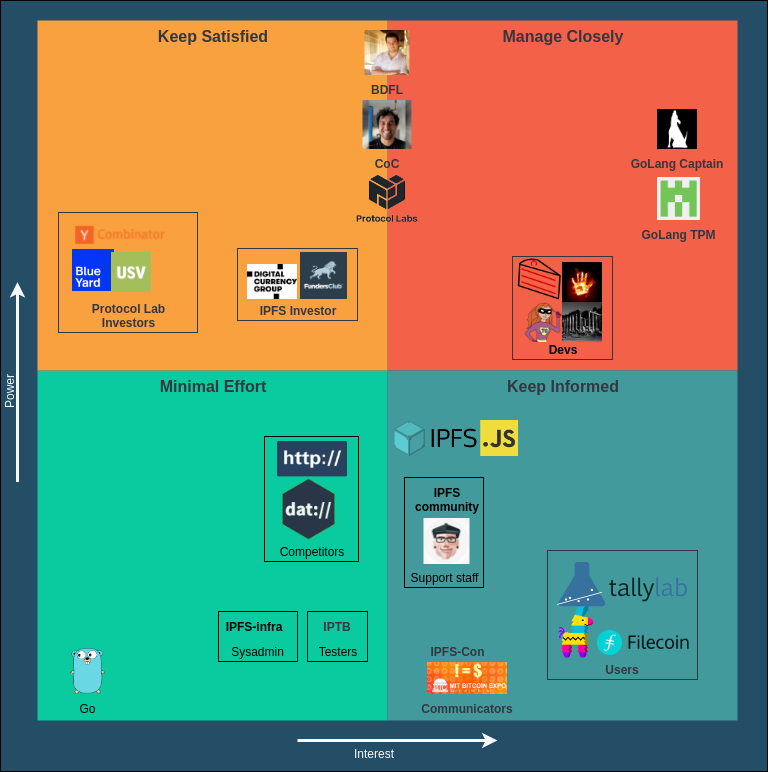
To visualize the power and interest of stakeholders, we created a power-interest grid. Stakeholders with the most power and interest are located in the top-right quadrant. The Golang IPFS Captain and TPM are in charge of the direct course of the project. The developers are also located in this quadrant, but have less power.
In the top-left quadrant, the investors can be found. The BDFL and the Captain of Captains are somewhere in between the top left and right quadrants. They are in charge of the overall vision and progress of the general IPFS project. As they make top-level decisions, they have a lot of operational power, but are less involved in the specific implementation of the go-ipfs project.
The users and projects that depend on the go-ipfs project are in the bottom right quadrant. They need to be up to date with the project, so that any major change won’t affect them.
In the bottom left quadrant, we have suppliers. The Go language has some influence on the project. If Go changes, the project will be affected.
Context View
The context view describes relationships, dependencies, and behaviors between IPFS and external entities.
System Scope
IPFS is a protocol for a distributed file system whose goal is to make content delivery truly decentralized. Go-ipfs serves as its original and reference implementation.
It consists of a daemon and a command line interface (CLI). The daemon contains an HTTP server through which the CLI and other apps can communicate. It is also possible to mount IPFS to /ipfs on the local filesystem, which allows arbitrary apps to access the content stored on IPFS without communicating with the IPFS node directly.
The Go implementation is used by end users and service providers. Web apps usually use its JavaScript implementation as it is possible to run it in a web browser without any software installed on a client.
Context Model
To visualize relationships with external entities, a context model diagram has been designed.
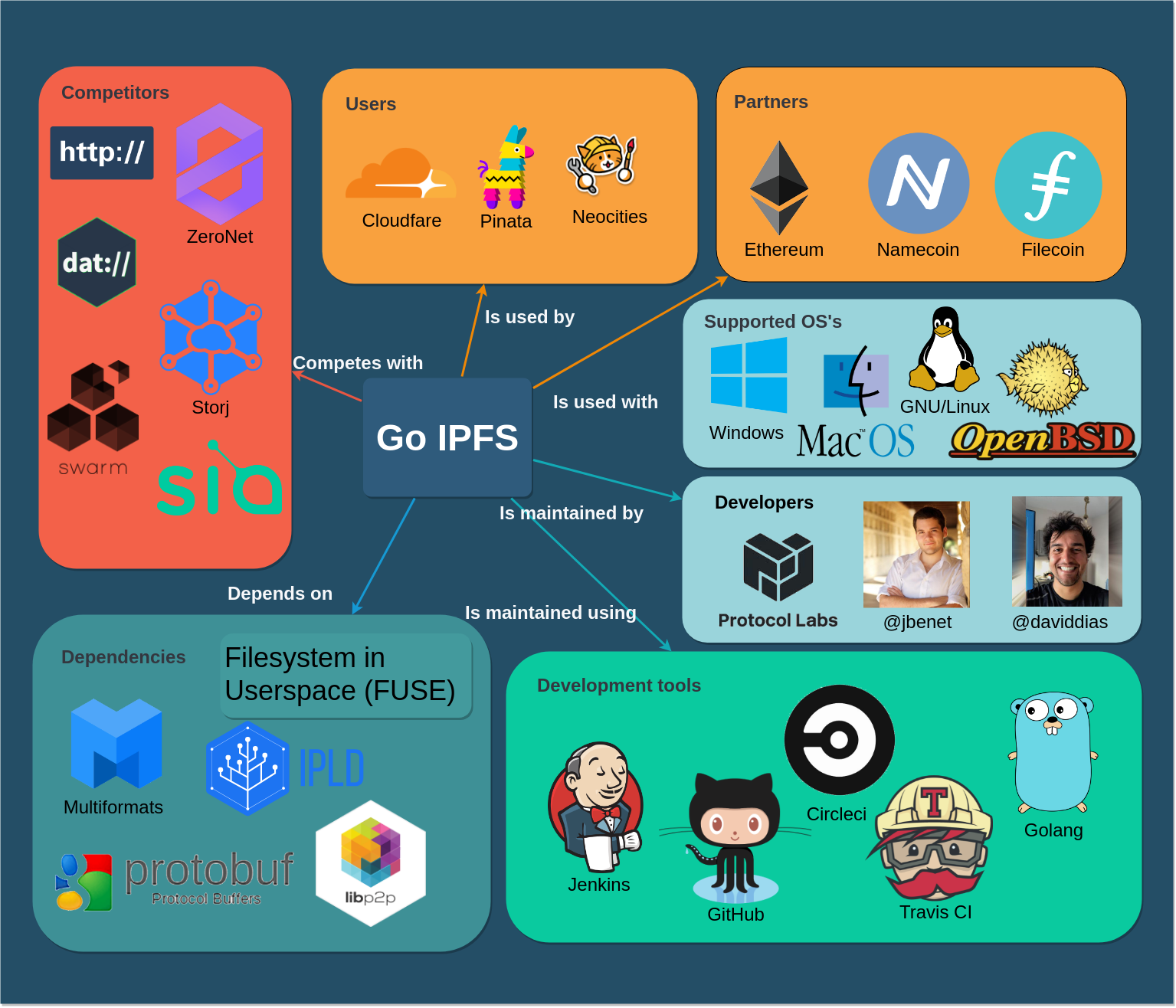
IPFS is developed by Protocol Labs, a research and development company. Its development team is globally distributed, just like the Internet itself. The main contributors and decision makers of the go-ipfs project have been analyzed in the previous section.
The development including most of the decision making happens on GitHub. There are several CI tools used for running tests and code analysis, including Jenkins, CircleCI and Travis.
IPFS depends on other projects developed by Protocol Labs, especially libp2p (a network stack for peer-to-peer applications), IPLD (Interplanetary Linked Data), and Multiformats.
For the content to be available, it has to be present at least on a single node in the network. As end-user nodes go offline frequently, there is still a need for servers to store a copy of data if there is a requirement for permanent availability guarantee. Seeing this as a business opportunity, several pinning services (e.g. Pinata) started to provide pinning of IPFS objects for a monthly fee. Another alternative would be to provide an incentive for users to store data of other users and keep the network decentralized. Filecoin, another project of Protocol Labs, is expected to introduce that incentive in the future.
Besides regular users, there are several parties who are interacting with IPFS. The project is interesting for website creator tools like Neocities, which are starting to use it to host static content. Cloudflare, one of the largest CDN providers, is running their own IPFS gateway and allows developers to connect an existing domain using DNS to a directory stored on IPFS. Other tools that are compatible with IPFS and aim to replace the centralized DNS are Namecoin and Ethereum Name Service.
The ultimate goal of IPFS is to replace HTTP for serving static content and make The Internet truly decentralized. For that reason, we can see the HTTP protocol as a competitor. Freenet and ZeroNet, which have similar goals, are direct competitors. Finally, any public distributed file system could be seen as an indirect competitor.
The application is multiplatform and can be run on Windows, Linux, and macOS.
Technical Debt
During our research, we found that the developers are constantly paying attention to code quality and try to maintain the quality of the software in various ways, but especially by detailed code reviews and discussions.
We analyzed the technical debt of go-ipfs in several ways. Firstly we used SonarQube, then we analyzed code manually and in the end, we decided to check if developers discuss technical debt in Pull Requests or in issues.
SonarQube Analysis
We use SonarQube 6 to analyze repository with regard to vulnerabilities, code smells and possible bugs.
| Metric | Bugs | Vulnerabilities | Debt | Duplications | Duplication Blocks | Coverage |
|---|---|---|---|---|---|---|
| Value | 0 | 0 | 4d 3h | 1.1% | 18 | 0.0% |
As can be seen, no bugs or vulnerabilities have been discovered in the code. Also, technical debt is on a low level as having on 4 days 3 hours. Duplications are also on the low level (1.1%). Further analysis shows that the 324 code smells consist of:
- 69 TODO comments
- 12 not following the naming convention
- 47 defining a constant instead of duplicating literal
- 50 refactor function to reduce Cognitive Complexity
- 124 remove unused parameters
SOLID Violations
Generally it is not so easy to find violations of SOLID rules, however,
function getOrHeadHandler in the file
go-ipfs/core/corehttp/gateway_handler.go (226 lines) is great example of
violation of Single Responsibility Principle. Many parts of this large function
could be extracted to separate functions to improve readability and testability.
In general case, as we noticed from analysis of Pull Requests and manual analysis of the code, developers try to follow SOLID rules and most of the function are well-written.
Documentation Debt
The project has two types of documentation: the folder /docs is used to
explain how to use the product, while the comments in the code are used to
explain the implementation and can be used to generate documentation using
godoc. The code itself has very
sparse documentation and some files do not have any
documentation at all. After analyzing the questions on the
discuss.ipfs.io website, a lot of questions concerning
incomplete/missing documentation have been found. There is no visible requirement for
creating documentation in the contribution guide. The
project has some substantial documentation debt that can lead to a decrease in
development speed and especially make onboarding of new contributors slower.
Testing Debt
To manage testing of such a complex repository, developers have some tools to perform that:
- unit tests stored in files with suffix
_test.go - ipfs-tb repository (IPFS own testbed)
- test module of the go-ipfs repository (this module contains online and offline tests of project functionality)
As ipfs-tb appears to be another repository which actually performs its task as testbed quite well, we decided to focus on the analysis of test module and unit tests. Detailed description of test module is done in development view.
By manual analysis of code we noticed two important things:
- many tests are not executed correctly (they should compare values instead of just logging)
- there is a small number of unit tests
Test module of the project and ipfs-tb repository are good examples of integration tests and environment for manual testing.
As SonarQube is not adding both unit tests and shareness tests in its calculation, we decided to investigate further using other tools. While investigating the CI tool codecov used by the go-ipfs team, we observed that code coverage is on the level of 62.32%.
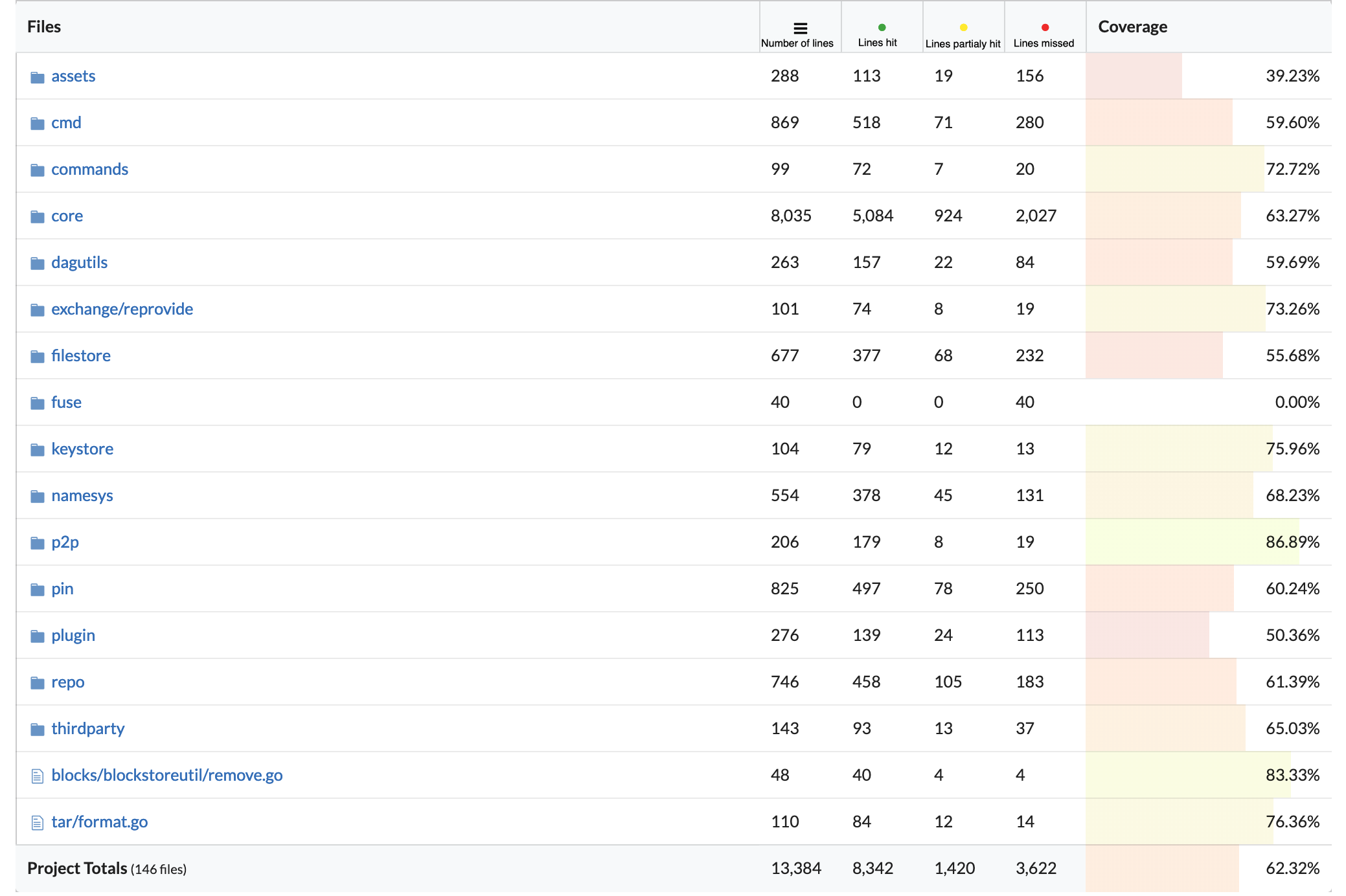
Some modules are tested more in depth, however, the most important module of the project, core, has only 63% of code coverage (codecov is calculating ratio between lines hit and all lines). It also is the largest module of the project, however, by more detailed analysis of this module we observed that overall most classes have code coverage in the range of 60-70%. We think that this number could be improved to decrease the technical debt of the project.
Developer Discussions
To investigate if developers discuss a lot about the possible technical debt we decided to look for a few keywords (“technical debt”, “refactor”) in Pull Requests and issues.
In terms of discussion in issues, there are quite a few issues trying to discuss more specialized problems. As an example, we can present the issue #4843 which discusses a technical debt in the CLI. Another example could be the issue #5723 focusing on testing and refactoring of the block exchange protocol.
In terms of discussions in the code, we observed 78 TODO and 9 FIXME comments in the source code.
Technical Debt Evolution
To observe technical debt evolution, we decided to run SonarQube on the latest release version and a few older versions from the past three years.
| version | technical debt | issues | TODOs | Duplications | LOC |
|---|---|---|---|---|---|
| 0.4.19 (02.2019) | 4d 3h | 325 | 97 | 1.1%, 18 blocks | 27k |
| 0.4.17 (08.2018) | 3d 7h | 356 | 93 | 1.6%, 54 blocks | 36k |
| 0.4.14 (03.2018) | 4d 2h | 353 | 186 | 1.7%, 59 blocks | 36k |
| 0.4.10 (07.2017) | 4d | 374 | 152 | 1.3%, 61 blocks | 37k |
| 0.4.2 (05.2016) | 8d | 541 | 184 | 1.3%, 73 blocks | 58k |
By analyzing the basic values we can see that the technical debt is fluctuating around 4 days. It is also clear that in the last year architects decided to extract some modules outside of the project as we could observe a significant loss in LOC between 0.4.17 and 0.4.19 versions. The number of TODOs, issues and duplications reduced throughout the versions, which indicates that the system is slowly getting more mature.
Conclusions to Technical Debt
From our research of technical debt we noticed that developers are trying their best to improve quality of the code, they discuss a lot on almost every GitHub issue before implementing the change, but also aim to increase code readability and understanding. In general, technical debt in terms of code quality is not remarkable, however, documentation debt is significant. We observed that there is still quite a lot of functions to be covered by the tests. As our remedies for the code we would consider:
- improve documentation and add the requirement to contribution guide to enforce documenting the code
- reduce Cognitive Complexity in longest functions as one can get lost while trying to understand or correct the code
- cover more blocks with tests
- improve tests implementation (e.g. real comparison, not only checking if it throws the exception)
- adding more constants instead of duplicating the same parameter in various places
- revisit duplicated blocks
- remove unused parameters where it is possible to improve code readability
Development View
In this section we explore the architecture of go-ipfs from the development viewpoint. We discuss mainly the package structure organization, responsibilities of different modules, dependency management, and testing approach.
Package Hierarchy
The whole project is separated into many reusable components. The following diagram gives an overview of the main packages, shows dependencies between them, and groups packages by layers of the IPFS stack. The go-ipfs repository then serves as the main package which wires all components together, allows to run an IPFS node daemon, and implements the CLI.
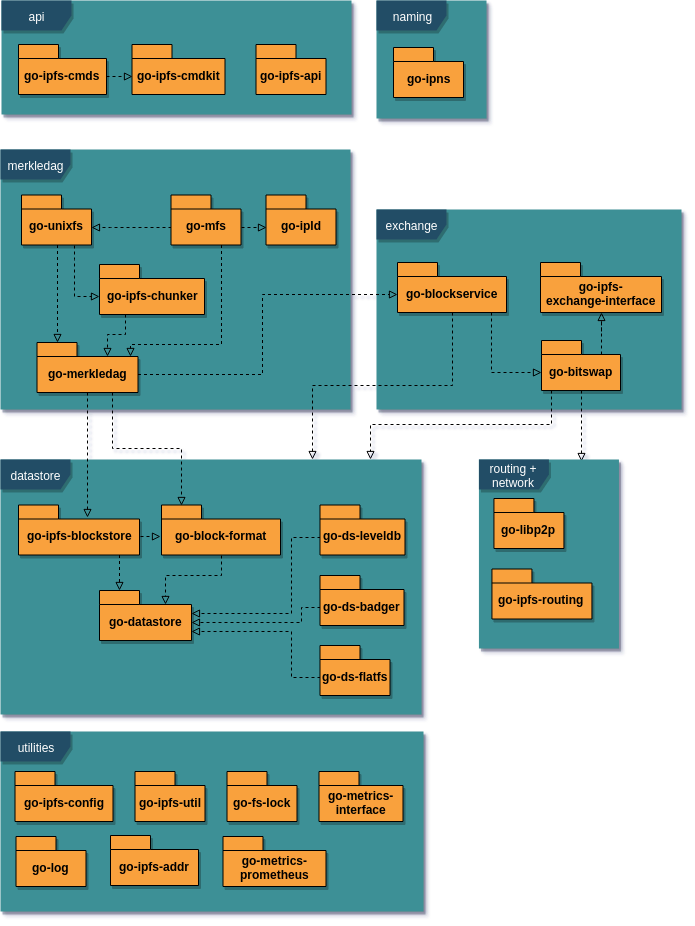
Network
The network layer handles point-to-point communication between nodes in the network and is based on NAT traversal techniques like hole punching, port mapping, and relay. It supports multiple transports as TCP, UDP, or WebSockets. The network layer is implemented in the libp2p library.
Routing
The routing layer server two purposes. First, it provides peer routing to help find other nodes in the network. An initial peer discovery is performed by connecting to a configurable bootstrap list of reliable nodes, which are in turn used to discover other peers.
Secondly, it provides content routing to find data published on IPFS. The current implementation is based on a Distributed Hash Table (DHT) protocol Kademlia, which is also used for example in BitTorrent.
Block Exchange
Data exchange in the IPFS protocol happens by exchanging data blocks using a BitTorrent-inspired protocol BitSwap, which incentivizes block storage and exchange. Each node has a list of blocks it maintains and a list of blocks it wants to acquire. Furthermore, each pair of nodes has a ledger maintaining number of bytes uploaded and downloaded. As the ratio of downloaded to uploaded bytes for a node increases, it is likely that other node will refuse to serve blocks until the debt ratio improves.
Merkledag
The Merkledag is the main data structure for representing files in IPFS. It is a directed acyclic graph (DAG) whose edges are hashes and nodes represent data corresponding to those hashes. IPFS is content-addressable, which means that each file can be accessed by knowing its hash. This allows for content deduplication, as multiple files with the same content are physically only stored once thanks to the fact they have the same hash. Git takes advantage of the same principles for efficient file versioning.
Files are addressed by multihashes, a self-describing hash format. A multihash is composed of a hash algorithm name, the length of the hash and the hash itself. This allows to easily upgrade to a new hashing algorithm in future while maintaining backwards compatibility.
IPFS currently allows blocks up to 1 MiB. This means files larger than this have to be split by a chunker into small chunks. Those chunks are used to build a DAG.
In order to add the functionalities expected from a fully-fledged filesystem, another layer of abstraction is added with UnixFS, which specifies certain meta data to add features such as symlinks and directories.
While immutability is inherent in the file structure of IPFS, it is not always wanted. For mutability, another abstraction layer, Mutable File System (MFS), is added. In UnixFS, files and directories are addressed by the hash of the data contained within the files. In MFS, this is abstracted away behind human readable names.
Data Store
The persistant block storage is provided by datastores. Besides the default flatfs implementation which uses sharded directories and flat files, there are also experimental datastores using BadgerDB and LevelDB key-value databases with better performance.
Naming
The content-addressable data are by their nature immutable. Whenever the content is changed, its hash and thus the address also changes. To allow modifying shared data without need to distribute the new address each time the content is changed, there is a naming layer called InterPlanetary Name System (IPNS). Every node has a public-private key pair, and names in IPNS are simply hashes of public keys. A node can assign an IPFS hash to its IPNS address and distribute the record using the IPFS routing system. The idea is based on the Self-certifying File System (SFS) 7.
CLI Architecture
There are several interfaces that can be used to communicate with an IPFS node. First, the user can communicate with the IPFS daemon via an HTTP API. Secondly, the user can use the CLI, which is able to perform some commands locally, but for online commands it requires a daemon with which it communicates over the HTTP API. Finally, application developers can include the go-ipfs package as a dependency and use its Core API.
The architecture of the CLI is shown in the following diagram. First, CLI
Parser parses the command and its arguments and forwards it to the CLI
Dispatcher. Each command is defined in a separate Command struct implementing
a Run function which makes required calls either via Core API to the IPFS node
directly, or via the HTTP API to the IPFS daemon in case the daemon is running. The
command can also implement a PreRun hook to preprocess the user input and
PostRun to format the output.
The structure of the daemon is quite similar, apart from the input handling, to the structure of the CLI. The HTTP-API server accept incoming calls, which are dispatched and called against the IPFS node.
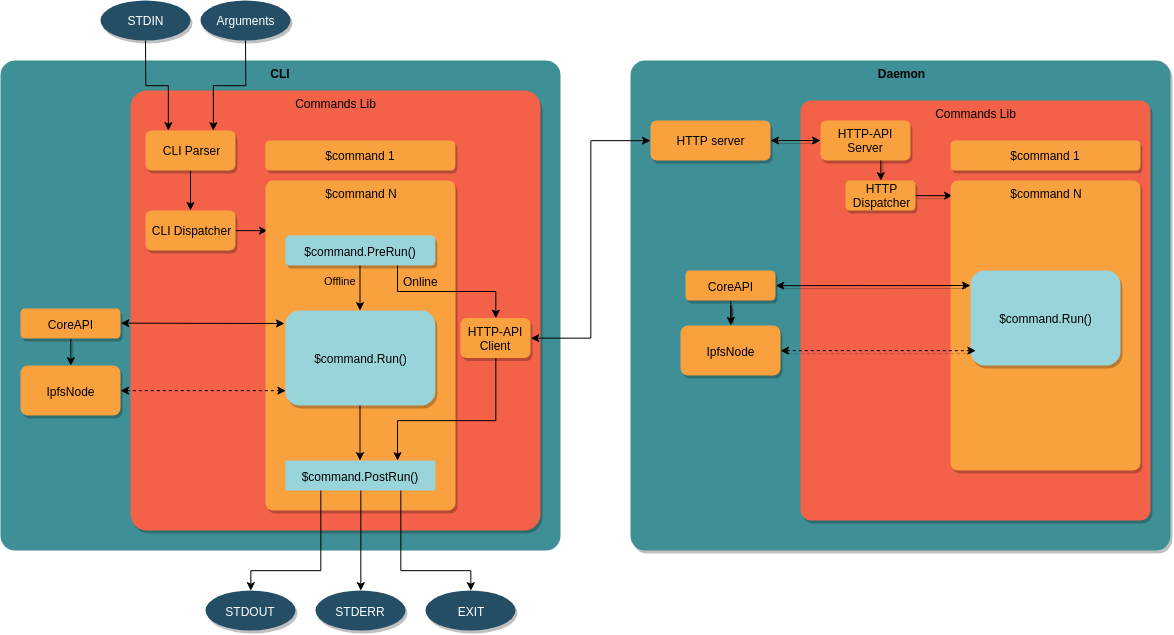
Dependency Management
As opposed to a monorepo 8 strategy adopted by many companies, IPFS tries to maintain modular architecture by developing each larger package in a separate Git repository. While this promotes reusability and enforces strict separation of concerns, it comes with more difficult development and dependency management if multiple components need to be changed at the same time.
Until recently, Go tool did not allow to depend on specific versions of external
packages. Therefore, IPFS team came up with their own package management tool
gx, which allows to publish versioned
packages on IPFS and in turn depend on the specific version of a package by
specifying its hash in package.json.
Since introduction of Go 1.11 in August 2018, there is an official support for versioned modules. 9 As it was not sustainable to maintain both systems, IPFS is now in the process of switching over to go modules and dropping gx support. 10
stored in a single monolithic repository
Testing
There are two types of tests in the project. Firstly, traditional go unit tests
are stored in files with _test.go suffix just next to the source code files in
their respective packages.
Integration tests located in the /test directory are bash scripts written with
help of Sharness, a shell library for
testing Unix programs. It is inspired by the test suite of the Git project, and
it is developed by an IPFS developer @chriscool.
All tests are run automatically by CircleCI for every Pull Request.
Deployment View
In this section we explore IPFS from the deployment perspective, specify supported platforms, hardware requirements and runtime dependencies.
At the base of any IPFS deployment will be the IPFS daemon. The IPFS daemon is the base node that communicates with other nodes using p2p protocols in order to participate in the global IPFS network. The daemon may add, aquire, and serve content for the network, or for the clients that are dependent on it.
Installation
Release versions of go-ipfs come in prebuilt packages for all supported platforms and can be downloaded from the distributions page, which is hosted on IPFS itself. It can also be installed using package managers specific for target platforms. Another way is to install using the ipfs-update tool, which also provides a convenient way to update the software and revert to the previous version in case the newly installed version has any issues.
System Requirements
IPFS can run on macOS, FreeBSD, Linux and Windows. There are prebuilt packages for i386 and amd64 CPU architectures for all systems. On Linux, arm and arm64 architecture is supported as well. The program requires at least 1 MB RAM for stable runtime, though 2 MB RAM is recommended. 11
Network Requirements
The daemon uses port 4001 to communicate with other peers in the network. The
gateway which is used to access the IPFS content is running on port 8080 by
default. Therefore, the firewall should be properly configured so that those
ports are open for the TCP protocol.
There is also a REST API running on the port 5001. However, that one should
not be made accessible from the public network. This would be considered a
vulnerability as anyone would be able to change the node configuration remotely.
FUSE
For daemon to be able to mount to /ipfs or /ipns namespaces, FUSE
(Filesystem in Userspace) needs to be installed. FUSE support varies across
different operating systems. The installation on Linux is straightforward, as
fuse should be available in most package managers. On macOS, it is required to
use osxfuse >= 2.7.0, as it has been discovered that previous versions cause a
kernel panic. For that reason, the IPFS daemon checks the osxfuse version and
prevents mounting on older versions. Mounting is currently not supported on
Windows. 12
IPFS Cluster
For large-scale IPFS deployments, IPFS cluster, a pinset orchestration tool, can be utilized. It consists of a cluster service that should be run on the server along with go-ipfs, and a client CLI application which helps to manage pins across a large cluster of IPFS daemons.
Conclusion
This chapter gives an overview of the IPFS project and particularly the architecture of its Go implementation. Firstly, we identified different stakeholders interested in the project. To better understand the structure, relationships, and dependencies, we created the Context and Development View. We also examined the technical debt of the project in terms of code quality and testing perspective. Finally, we analyzed the requirements for deployment environment in the Deployment View.
We noticed that the project is very modularized to make it reusable and easy to change, however, in the beginning, this makes it a bit difficult to understand how all pieces fit together.
The team is putting great efforts to maintain a good quality of the code. There is also a great number of discussions about possible improvements in terms of the current state of the project and team operation. Nonetheless, we found that the lack of code documentation and low unit test coverage make it difficult to understand the inner workings of the code for new contributors. This oversight is probably caused by the fact that the project is still in an alpha version and evolves quickly.
Overall, we are very optimistic with the direction of the project and hope it will help to shape the future where the Web is decentralized again, as it was supposed to be from the beginning.
-
http://clgiles.ist.psu.edu/papers/Computer-2001-web-references.pdf#page=5 ↩
-
Nick Rozanski and Eoin Woods. Software Systems Architecture: Working ↩
-
https://www.sonarqube.org/ ↩
-
https://en.wikipedia.org/wiki/Self-certifying_File_System ↩
-
Monorepo is a development strategy where the whole codebase is ↩
-
https://github.com/golang/go/wiki/Modules ↩
-
https://github.com/ipfs/go-ipfs/issues/5850 ↩
-
https://github.com/ipfs/ipfs-update ↩
-
https://github.com/ipfs/go-ipfs/issues/5003 ↩
